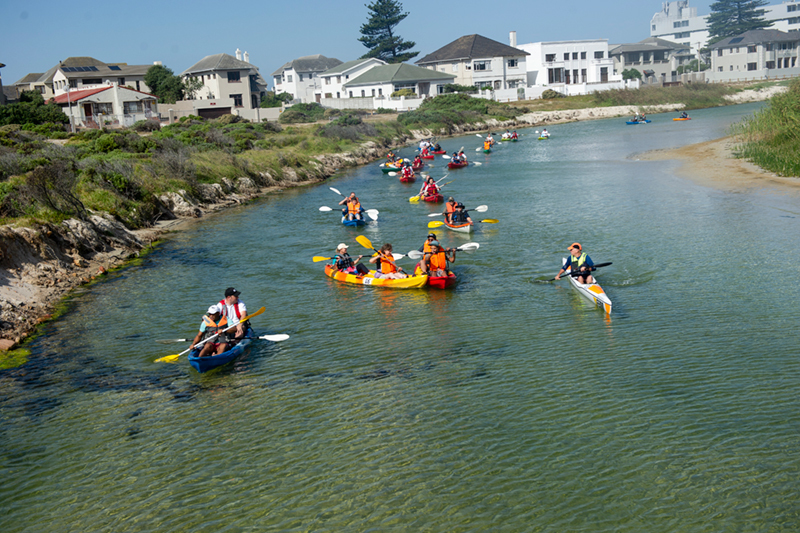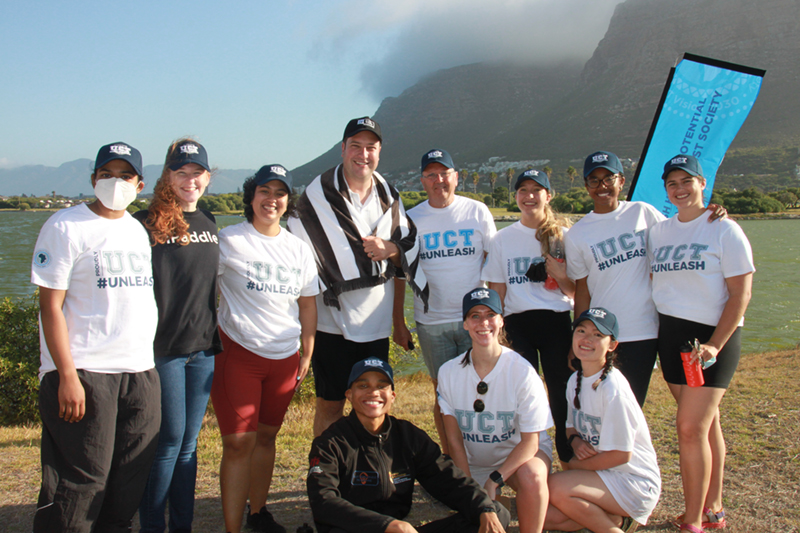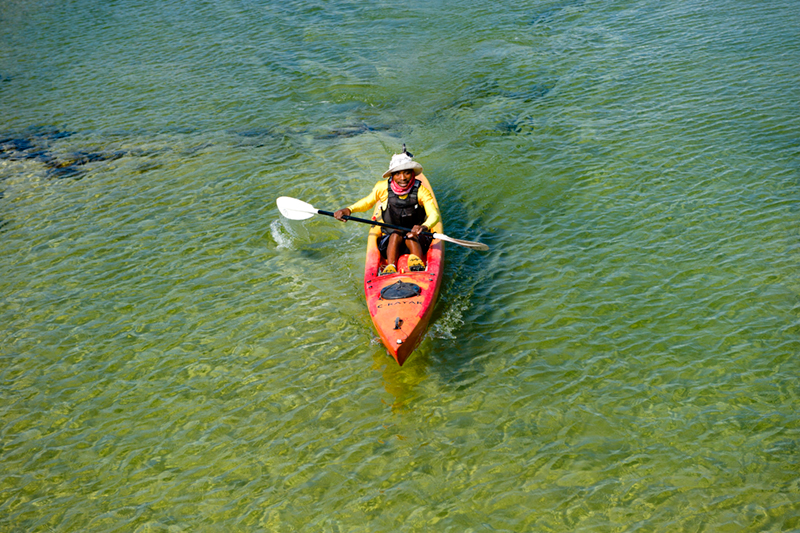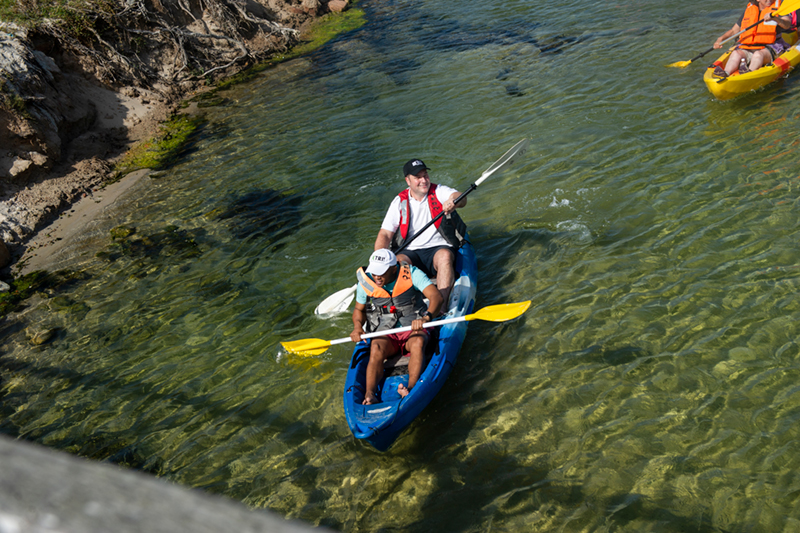World Water Day Paddle: a commitment to a water-sensitive city
24 March 2022 | Story Helen Swingler. Read time 9 min.
Battling strong winds and sandbanks near its mouth, a colourful flotilla of kayaks set off to explore Zandvlei lagoon on World Water Day, 22 March. Organised by Dr Kevin Winter of the University of Cape Town’s (UCT) Future Water Institute and co-hosts the City of Cape Town, the World Water Day Paddle highlighted pollution in the city’s rivers and estuaries. It also underscored a shared commitment to address this.
The joint event was modelled on Dr Winter’s annual Peninsula Paddle along the Liesbeek River.
It both strengthened the Future Water Institute’s research partnership with the metropole and a shared a vision for a water-sensitive city.
The UCT group included Winter’s fellow water researchers as well as his third- and fourth-year students in the Department of Environmental and Geographical Science, all togged out in the university’s new Vision 2030-branded T-shirts and caps.

Members of the City’s executive included Executive Mayor Geordin Hill-Lewis, Councillor Zahid Badroodien of the Mayoral Committee for Water and Sanitation, and executive director for Water and Sanitation, Michael Webster.
Among the paddling party were the Khayelitsha Canoe Club, Friends of the Liesbeek and a small group of Dutch academics with links to the City.
Fish nursery
Zandvlei is an important estuary and nature reserve between Muizenberg and Marina Da Gama. It has been closed to recreational users for over a year because of high levels of E. coli and other pollutants. While this is also cause for alarm for residents living at the lagoon’s edge, the estuary is an important nursery for several fish species.
These are white steenbras, carp, garrick (leerfish), tilapa, Cape stumpnose as well as mullets, elk and goby. The white steenbras, Cape stumpnose and garrick are all listed in the International Union for Conservation of Nature (ICUN) as endangered.

Better management, improved behaviour
Like other peninsula waterways, Zandvlei carries the burden of socio-economic and environmental stressors: urbanisation, burgeoning informal settlements, land invasions, and sewage infrastructure failures and blockages.
The situation must change, said Winter.
“If we can paddle, and even swim in our waterways, then we can safely say that Cape Town is becoming a healthy city – we are assured of its safety.”
“Failure to address these challenges is an unacceptable outcome. It is going to demand much better water management; improved behaviour, education and support to curtail from discharging pollutants into waterways; and a firm commitment to restore the blue and green corridors that surround our lakes and rivers.
“If we can paddle, and even swim in our waterways, then we can safely say that Cape Town is becoming a healthy city – we are assured of its safety. It can’t become an aspirational call only, but a firm resolve from the City and its citizens.”
Winter said it was encouraging to have the mayor and city officials actively participating in the World Water Day Paddle.
“The paddle today is symbolic of a journey that is going to be arduous and challenging but not without long-term rewards in helping to make Cape Town a city with a future for all and a place where we want to live,” he said.
“It signals a new level of commitment to highlight concerns about the state of Cape Town’s waterways.”
The event also raises the profile of programmes such as Liveable Urban Waterways and the journey towards a water-sensitive city.

In perhaps a first for the city, Hill-Lewis delivered his address barefooted and wet after a dousing in the vlei. To effect the envisaged change, he committed to a 10-point action plan:
Briefly, these points are:
- The Water Quality Improvement programmes and its associated Pollution Abatement plans are being developed and implemented to address pollution and poor water quality at a river catchment (or sub-catchment) scale.
- The City aims to spend a minimum of R8 billion in wastewater treatment work upgrades over the next 10 years, with several projects under way.
- Some R426 million will be invested in upgrading of sewage pump stations and related sewer infrastructure over the next 10 years. The pump stations budget has been increased by R20 million and will target security electrical component upgrades.
- 5 million is being budgeted for the 2021/2022 financial year for the Sewer Pipe Replacement Programme. The Water and Sanitation team is on track to reach its target of replacing 26 000 m of sewer pipeline by the end of June 2022.
- 2 million will be invested between now and June 2026 on capital projects to improve the health of our vleis. These include acquiring weed harvesters, a vessel for Zandvlei, and lowering the Zeekoevlei weir. A further R300 million will be spent on operations over the next five years.
- Additional efforts in the Sand River catchment, which Zandvlei is part of, include:
- The Liveable Urban Waterway Programme rehabilitates waterways using nature-based solutions, green infrastructure and water-sensitive design approaches – five projects worth R50 million are under way in the Sand River catchment to improve ecosystem health, reduce flood risk, improve access and amenity use of the waterways and better water quality in Zandvlei.
- More litter fences, litter booms and litter traps will boost waste-intercepting structures in the Sand River Catchment in the next five years.
- Partnerships with the Sand River Catchment Forum and the Zandvlei Protected Area Advisory Committee will be established to better communicate with stakeholders on the impact of pollution.
- Public education and awareness programmes such as Bin It, Don’t Block It will be enhanced.
- By-law enforcement teams will continue to monitor hot spots and will act against those who contribute to pollution.
- The Urban Waste Management Directorate will continue to operate free drop-off facilities for 1.5 tonnes of recyclables (electronics, garage waste and builder’s rubble).
- The City will look at ways to reduce the impact of unlawful occupation.
Emulate, learn from other cities
Cape Town is not alone in its vision of a water-sensitive city. Others across the globe are cleaning up their waterways. Paris, for example, has pumped over €1.4 billion since 2016 into cleaning up the Seine ahead of the 2024 Olympic Games. The open-water and triathlon events are scheduled to take place on the river.
The Dutch team shared Amsterdam’s efforts to clean up their waterways and presented the mayor with a special gift: a framed “then” and “now” photograph of the city’s waterways; before and after a clean-up spanning many years. In 2014 the city’s dream of a swimmable and liveable city was celebrated with an annual City Swim.
They hoped the images and success story would inspire City of Cape Town officials and researchers to persevere with their own vision.
 This work is licensed under a Creative Commons Attribution-NoDerivatives 4.0 International License.
This work is licensed under a Creative Commons Attribution-NoDerivatives 4.0 International License.
Please view the republishing articles page for more information.



















